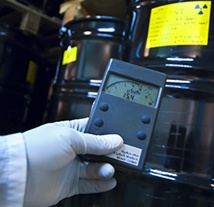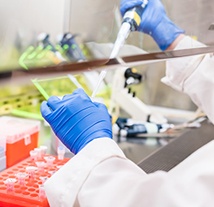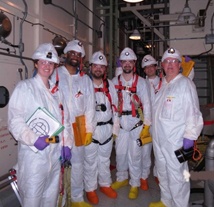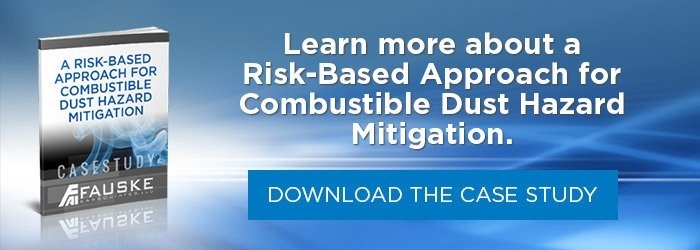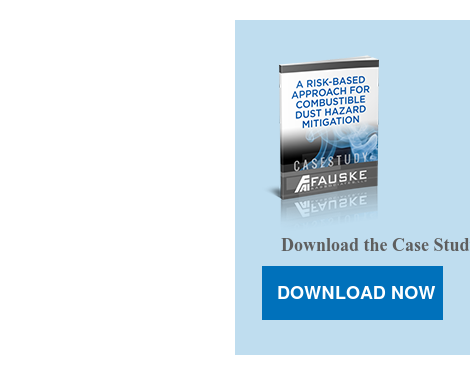
Dust explosions are a serious hazard in process industries. Explosion events can cause loss of land, labor, capital and in the very worst cases, life. On this page, we discuss in detail the use of Kst and Pmax tests for combustible dust.
Table of Contents
About the Author
Ashok Ghose Dastidar, PhD MBA is a specialist in the areas of Chemical Process Hazards Analysis, Flammable Dusts, Liquids & Vapors Explosion and Combustion Hazards Analysis and Testing and Electrostatic Hazards Analysis. Recognized as an industry expert, his work has appeared in numerous journals and publications, has been a featured presenter at more than 23 conferences, serves on the NFPA 664, 61, 484 and 654 technical committees, the ASTM E27.05 technical committee and sits on the editorial advisory board for Powder & Bulk Solids and Journal of Loss Prevention.
History
Per the Canadian Centre for Occupational Health and Safety: Essentially, a combustible dust is any fine material that has the ability to catch fire and explode when mixed with air. Combustible dusts can be from:
- Most solid organic materials (i.e. sugar, flour, grain, wood, etc.)
- many metals, (i.e. aluminum, titanium etc.) and
- Some nonmetallic inorganic materials (i.e. fiberglass, carbon, graphite, etc.)
Combustible dust is a particulate solid, traditionally defined as 420 - 500 µm or smaller that presents a fire or deflagration hazard when suspended in air or oxidizing atmosphere over a range of concentrations, regardless of particle morphology.
OSHA defines combustible dust as "a solid material composed of distinct particles or pieces, regardless of size, shape, or chemical composition, which presents a fire or deflagration hazard when suspended in air or some other oxidizing medium over a range of concentrations."
Dusts are created when materials are:
- Transported
- Handled
- Processed
- Polished
- Ground
- Shaped
Dusts are also created by:
- Abrasive blasting
- Cutting
- Crushing
- Mixing
- Sifting
- Screening dry materials
The buildup of dried residue from the processing of wet materials also can generate dusts. Essentially, any workplace that generates or handles dust is potentially at risk.
Like all fires, a dust fire occurs when fuel (the combustible dust) is exposed to heat (an ignition source) in the presence of oxygen (air) as demonstrated below:
Removing any one of these elements of the classic fire triangle eliminates the possibility of a fire.
Unlike a dust fire, a dust explosion requires two additional factors such as confinement and dispersion.
When the dust is disturbed, there is the potential for a serious explosion to occur under the right circumstances. A primary dust explosion can occur when a dust suspended within a container, room or piece of equipment is ignited. A secondary (often more powerful) explosion can occur when dust accumulated on floors or other surfaces is disrupted and lifted into the air and ignited by the primary explosion. The buildup of even a very small amount of dust can cause serious damage.
Dust can collect on surfaces such as rafters, roofs, suspended ceilings, ducts, crevices, dust collectors, and other History equipment. Housekeeping is very important, especially in facilities that generate dust within their processes. The buildup of even very small amounts of dust can cause serious damage if an event were to occur.
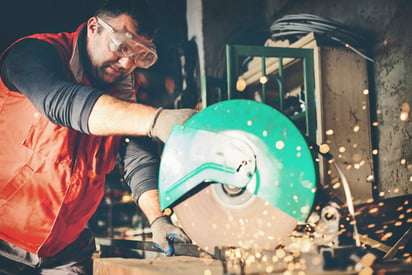
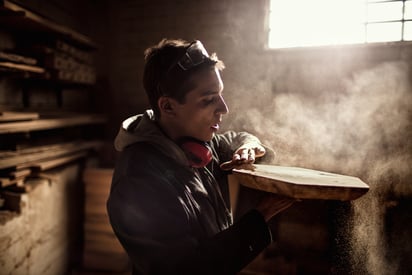
The explosion severity test generates the Kst and Pmax values which are the explosive properties measured in the laboratory
to quantify the severity of a dust explosion. The KSt value determines the normalized rate of pressure rise of a combustible dust and the Pmax value measures the maximum explosion overpressure generated in the test chamber. More simply put, these data values tell you how much pressure an explosion will generate and how fast the explosion will travel.
Combustible dusts are ranked into one of four classes; St0, St1, St2, St3. The level of explosion violence increases with the class number. A material that has zero risk (Kst = 0) of explosion is an St0 dust. All other dusts have an explosion hazard. Even a St1 dust generates sufficient power to cause a flash fire, compromise containment on a piece of equipment, or blow out the walls of a building. Grains, Sugar, Coal, PVC, Flour, etc. are typically considered St 1 class dusts. In fact, some of the most famous dust explosions case studies come from St 1 class dusts: such as the Imperial Sugar explosion in 2008 in Georgia, and (historically) the Washburn A Mill explosion in 1876.
The Explosion Severity test will tell you what “St Class” your sample falls within, which is helpful in guiding service providers as they analyze your equipment and your facility. The St class is based on the KSt value as follows:
St 0 - KSt value = 0
St 1 - KSt value less than/or equal to 200 bar-m/sec and greater than 0
St 2 - KSt value between 201 and 300 bar-m/sec
St 3 - KSt value greater than 300 bar-m/sec
While “explosion” data can be found for many typical dusts, companies are encouraged to test a sample of their specific dust for its explosive characteristics because the existing data is too general in nature. Various dusts of the same material can have vastly different characteristics particularly relating to particle size, moisture content, and shape. For example:
|
Material |
Moisture Content (wt.%) |
Particle Size (µm) |
Pmax (bar) |
KSt (bar-m/s) |
|
Wood Dust |
7.3 |
117 48% < 75 µm |
8.2 ± 10% |
129 ± 12% |
|
Wood Dust |
4.3 |
100% > 500 µm |
6.1 ± 10% |
17 ± 30% |
*Please note that the data represented in this table is for illustrative use only; do not use data for design purposes
The higher a Kst value is the more “energetic” the dust is but that does not change the danger associated with dusts having a lower Kst. In fact, some of the most well-known dust explosion case studies come from St 1 class dust.
The Explosion Severity Test is generally conducted in a 20L sphere because it is directly scalable to the 1m³ sphere, which is the original instrument used to test combustible dust. The 1-m³ chamber is considered to be the “gold standard” for dust testing and is useful for providing data in the instances where it would be beneficial to validate the results generated by testing in the 20-L chamber. For example, if a material generates a Kst value less than 50 bar-m/s; it is possible that test values are a result of overdriving. Overdriving is a phenomenon that occurs when the ignition source used to conduct experiments in the 20-L chamber preheats the test material and burns the dust cloud under study without really generating a true propagating flame. Another phenomenon/limitation of the 20-L chamber is known as “underdriving”. This is when the walls of the 20-L chamber abstract heat from the dust cloud explosion and thereby partially quenching the intensity of the deflagration.
Why are Kst and Pmax Tests Important? .jpg?width=450&height=338&name=GettyImages-642183882%20(4).jpg)
Dust explosions are a serious hazard in process industries. Explosion events can cause loss of land, labor, capital and in the very worst cases, life. At least 281 combustible dust fires and explosions occurred in general industry between 1980 and 2005. These events have caused at least 119 fatalities and 718 injuries in the United States. The fatal event at Imperial Sugar in 2008 that left 14 dead and many others injured was the impetus for increased attention to this subject by OSHA and the NFPA.
Explosion events have occurred in a wide range of industries and involved many types of combustible dusts, including:
- Grain elevators
- Food production
- Chemical manufacturing (e.g., rubber, plastics, pharmaceuticals)
- Woodworking facilities
- Metal processing (e.g., zinc, magnesium, aluminum, iron)
- Recycling facilities (e.g., paper, plastics, metals)
- Coal-fired power plants
In order to develop effective mitigation strategies to prevent such accidents from occurring, it is imperative to characterize the hazard risk of the materials you are working with. Testing your dust to determine the KSt & Pmax values is an essential first step for any type of equipment or process safety design. In particular, these values are used by manufacturers to validate the design of protection systems (such as proper housekeeping, spark detection, explosion venting, explosion suppression and explosion containment).
In the case of Imperial Sugar, poor housekeeping led to significant amounts of sugar and sugar dust accumulating throughout the facility. The excess of sugar (which is typically a St1 class dust) combined with a confined and poorly vented conveyer belt, triggered a massive blast and resulted in multiple secondary explosions. These secondary explosions were due to the blast disrupting the settled material and forming dust clouds that were then ignited by the initial explosion. Sugar in such quantities in the air and in layers can be considered extremely volatile. If routine housekeeping policies and procedures to remove sugar dust accumulations throughout the buildings based on the known characteristics of sugar were applied, it is likely that the explosion event would not have occurred.
How to use Kst and Pmax Tests Effectively
A large majority of companies seek out dust explosion testing for two reasons – one, to obtain data specifically for the installation/modification of equipment and two, for compliance purposes. The folks seeking data for the installation or modification of equipment or process change are often most interested in the “how bad can it be?” aspect and want to know the KSt and Pmax values for their material. Others, often at the urging of an AHJ (Authority Having Jurisdiction) such as OSHA, building inspectors, insurance companies, fire marshals, etc. are seeking data for compliance purposes.
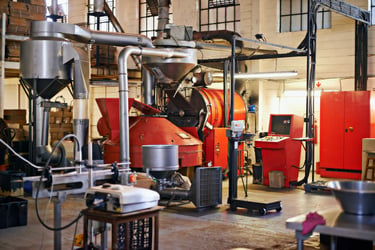 The Explosion Severity (Kst) test is performed within the 20-L chamber per ASTM E1226. Other explosibility parameters can be determined by testing within the 20-L chamber. Additional testing can include the Minimum Explosible Concentration (MEC) per ASTM E1515 and the Limiting Oxygen Concentration (LOC) per ASTM E2931. Explosibility testing in the 20-L chambers can also be performed per the EN 14034 methods. The values generated by these test methods provide valuable data to help create dust explosion hazard mitigation strategies.
The Explosion Severity (Kst) test is performed within the 20-L chamber per ASTM E1226. Other explosibility parameters can be determined by testing within the 20-L chamber. Additional testing can include the Minimum Explosible Concentration (MEC) per ASTM E1515 and the Limiting Oxygen Concentration (LOC) per ASTM E2931. Explosibility testing in the 20-L chambers can also be performed per the EN 14034 methods. The values generated by these test methods provide valuable data to help create dust explosion hazard mitigation strategies.
The level of risk can change from moment to moment, day to day and process to process. Additional hazards can be created due to the introduction of a new process, a temporary lapse in housekeeping, or a static electricity discharge caused by improper grounding. It takes ongoing vigilance and management of change to identify conditions in your plant that might cause a potential safety problem. Therefore, it is of great importance to ensure that your testing strategy and maintenance plans are always reviewed and kept up-to-date as well.
How Do Kst and Pmax Tests Impact Me?
Essentially, any facility or site that generates or handles dust is potentially at risk and can benefit from characterizing their dust.
For chemical engineers working on a new process or recipe, if dry ingredients are used then knowing the characteristics of the material enables safer and more efficient work. Data from explosivity testing can assist plant or safety managers or engineers responsible for upgrading existing dust collection systems or planning on investing on a new one. Additionally, for EHS purposes, knowing the explosivity of fugitive dust collecting in the work area complements hygiene requirements by providing valuable data to identify safe dust control processes and equipment such as vacuums etc., as well as addressing the dust hazards that exist inside process equipment.
The Experts in Kst and Pmax Testing
Fauske & Associates, LLC is recognized for its expertise in characterizing, assessing and mitigating combustible dust explosion and fire hazards in our state of the art labs. Recognizing that every dust and customer situation is different, we have always taken pride in our ability to provide data driven solutions to complex problems that they face in their unique processing environments. By working closely with customers we ensure that we understand their process and recommend and communicate the proper testing for their needs, along with solid reasoning for our recommendations.
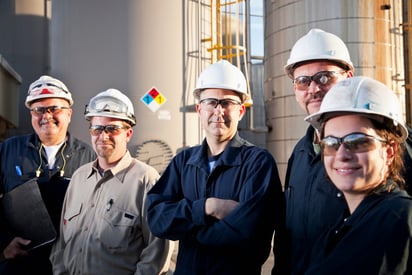 We have the opportunity to help reduce risk from dust hazards quite often. One area where we have provided assistance is when a material is extremely sensitive to electrostatic sparks and the customer needs our assistance in determining the best safety strategy. We have seen materials that react to electrostatics with an energy level of 1 mJ. To provide some perspective, when you walk across the floor and get a shock on a door knob, which is roughly 30 mJ of energy, which is 30 times more powerful than the energy to ignite some powders we have tested. In these cases, we can provide on-site assistance to find areas to reduce the chance for an electrostatic build up by providing options on how to properly handle the material.
We have the opportunity to help reduce risk from dust hazards quite often. One area where we have provided assistance is when a material is extremely sensitive to electrostatic sparks and the customer needs our assistance in determining the best safety strategy. We have seen materials that react to electrostatics with an energy level of 1 mJ. To provide some perspective, when you walk across the floor and get a shock on a door knob, which is roughly 30 mJ of energy, which is 30 times more powerful than the energy to ignite some powders we have tested. In these cases, we can provide on-site assistance to find areas to reduce the chance for an electrostatic build up by providing options on how to properly handle the material.
Occasionally we have customers that are surprised by their results. For example, in one instance where we recommended testing the customer was insistent that their material was not a combustible issue. This customer used the same rationale as many of our customers to say, “We have never had a problem.” In this case the material was hay and they were being asked to get their material tested for explosibility by an Authority Having Jurisdiction (AHJ). The customer thought that the large particle size and high moisture content made the material a non-issue in terms of explosibility. However, during the course of handling, most materials have a tendency to break off into smaller particles and lose a certain degree of its moisture while in process. As a result, what is often considered the “typical particle size and moisture content” may not be truly representative of the material that breaks away while in process. In this case, the material was found to be explosible and the customer has realized the need to start focusing on proper dust collection and installing explosion protection.
We Can Help
As experts in the area of hazardous dust, we recognize that there are numerous variables to consider when crafting a suitable combustible dust mitigation strategy. As such, we strive to provide the best data to our customers to enable them to make informed decisions regarding their process safety.
FAI is at the forefront for dust explosivity/combustibility testing offering a wide range of services related to characterizing, preventing and mitigating combustible dust explosions and fire hazards. In addition to laboratory testing, educational training and on-site consulting services are a frequent customer request.
FAI’s laboratory capabilities provide testing per ASTM and European (CEN) standards, which include common tests like the Explosion Severity Test - (KSt , Pmax and (dP/dt)max), the Minimum Ignition Energy (MIE), the Minimum Explosible Concentration (MEC), the Minimum Ignition Temperature of a Dust Cloud (MAIT), the Minimum Ignition Temperature of a Dust Layer (LIT), and Limiting Oxygen Concentration (LOC). These standards are the basis of NFPA codes for combustible dust as well as the OSHA Combustible Dust National Emphasis Program (NEP).
A testament to our capabilities is that we have had customers let us know that they have worked with other labs in the past and finding someone to talk to about their project was not an easy task, and acknowledge the value we provide when it comes to taking time in understanding their project and suggesting a course of action that is best for their particular needs.
For information on how we can assist with your combustible dust plan, contact us here.

